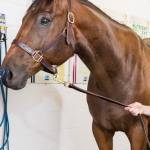New Technique Helps Roaring Horses After Surgery

Does your horse “roar” while he works? No problem, there’s a surgery for that!
Problem is, the overall success rate following surgery can vary markedly from an impressive 90% all the way to a frustrating 50%. Chronic coughing and difficulty swallowing rank among the most common reasons for surgical failure, both of which contribute to poor performance. Recently, a group of researchers noted that a flaccid aryepiglottic fold might be the underlying reason for these postsurgical complications, and a simple injection can resolve the problem.
“The term ‘roaring’ refers to a sound made by exercising horses when the left arytenoid cartilage droops into the lumen of the larynx, located at the top of the trachea. The unnatural position of this tissue impedes airflow in horses, decreasing their ability to perform due to reduced airflow to the lungs,” explained Kathleen Crandell, Ph.D., a nutritionist for Kentucky Equine Research (KER).
Roaring affects approximately 3-9% of horses, including Thoroughbreds, Standardbreds, Quarter Horses, Warmbloods, and drafts. Surgery remains the treatment of choice, with prosthetic laryngoplasty a frequently sought option. This procedure is also referred to as “tie-back” surgery because it involves using a strong suture to pull the arytenoid cartilage into its normal position. A tie-back can be performed in conjunction with related procedures, including ventriculectomy or cordectomy to remove other tissues of the larynx that sag into the larynx and obstruct airflow to the horse’s lungs.
“According to the American College of Veterinary Surgeons, coughing is the most common postsurgical complication with 5 to 10% of horses suffering from chronic coughing. Difficulty swallowing and aspiration pneumonia caused by inhalation of feed because of excessive opening of the larynx during a tie-back can also occur,” Crandell shared.
Enter researchers Vidovic and Delling*. Though their experience with roaring, technically referred to as laryngeal hemiplegia, they began to notice that some horses suffering from coughing and swallowing problems after surgery had thin aryepiglottic folds (AEF), which are tissues located near the bottom of the larynx. Further, when these horses were offered a bolus of molasses laced with a dye that the scientists could visualize using standard imaging techniques, they found that some feed entered the trachea rather than passing solely into the esophagus.
The researchers then elected to inject hyaluronic acid directly into the thin AEF of these horses to augment the tissue and help block the passage of food into the trachea.
Based on short-term data obtained from six horses, the researchers concluded that “the condition seems to be associated with an abnormal appearance and function of the AEF. Successful treatment is possible by augmenting the AEF. However, careful patient selection is mandatory.”
For horses with postsurgical complications, Crandell said, “Consider an anti-inflammatory supplement such as EO•3, which contains the marine-derived fish oils EPA and DHA. These ingredients are recommended by the American College of Veterinary Internal Medicine** to support the overall health of the respiratory tract and specific ailments, including inflammatory airway disease, part of the spectrum of equine asthma.”
*Vidovic, A., U. Delling. 2017. Aryepiglottic fold augmentation as treatment for late-onset dysphagia following surgical treatment of recurrent laryngeal neuropathy. Tierarztlich Praxis. Ausgabe G, Grosstiere/Nutztiere. 45(3).
**Couëtil, L.L., J.M. Cardwell, V. Gerber, et al. 2016. Inflammatory airway disease of horses—Revised consensus statement. Journal of Veterinary Internal Medicine. 30(2):503-515.








